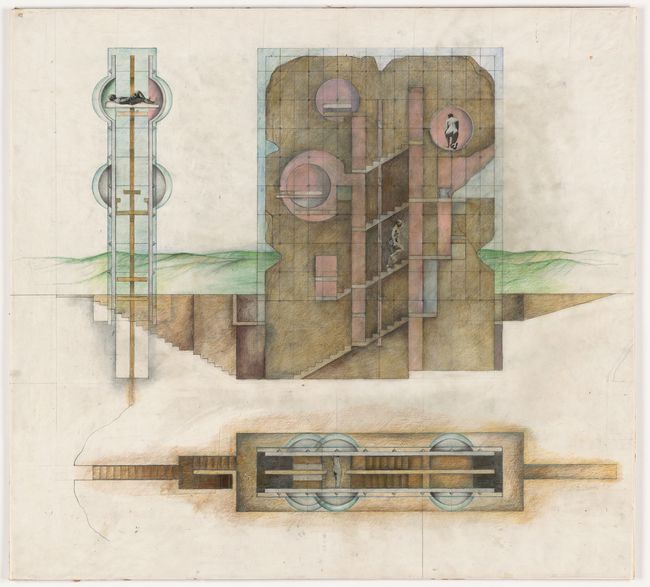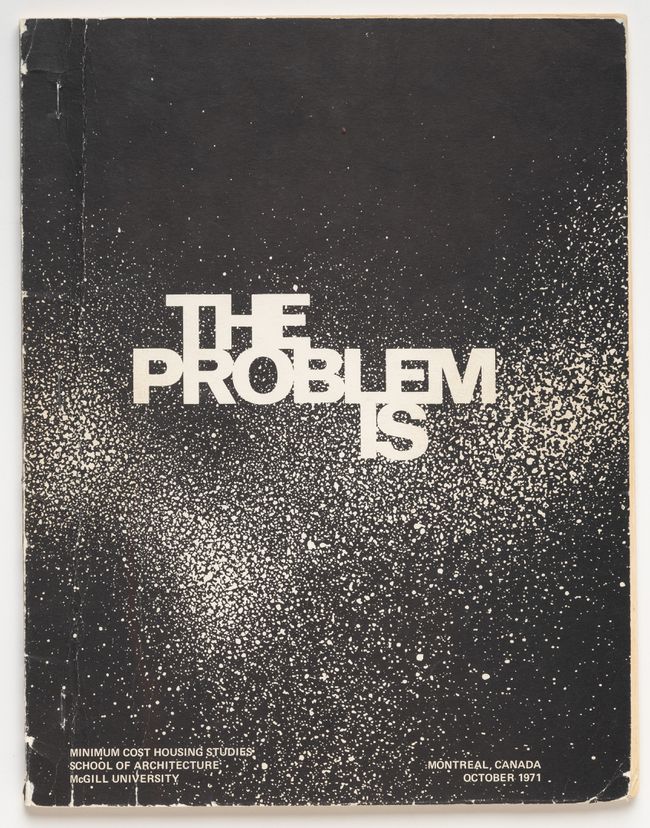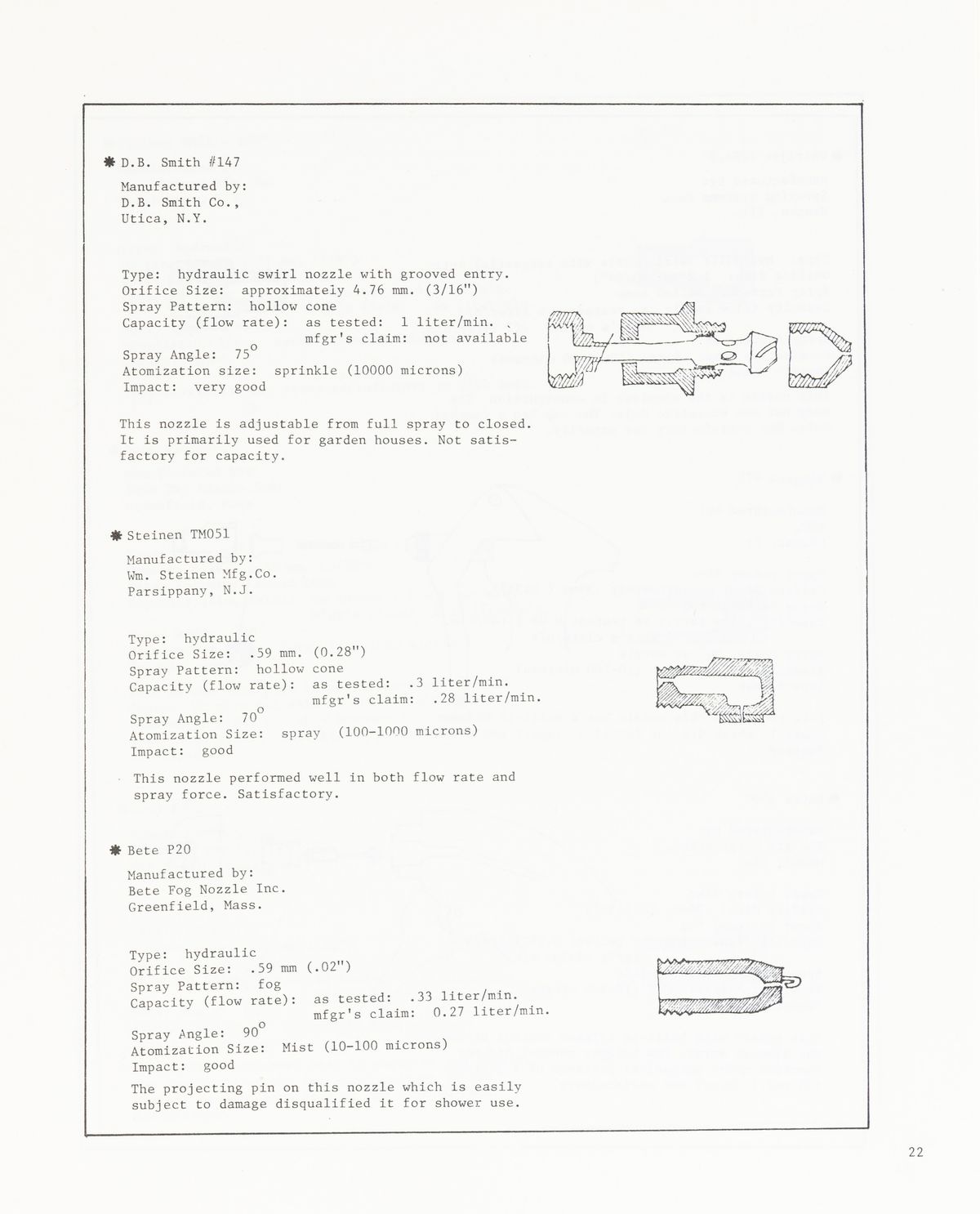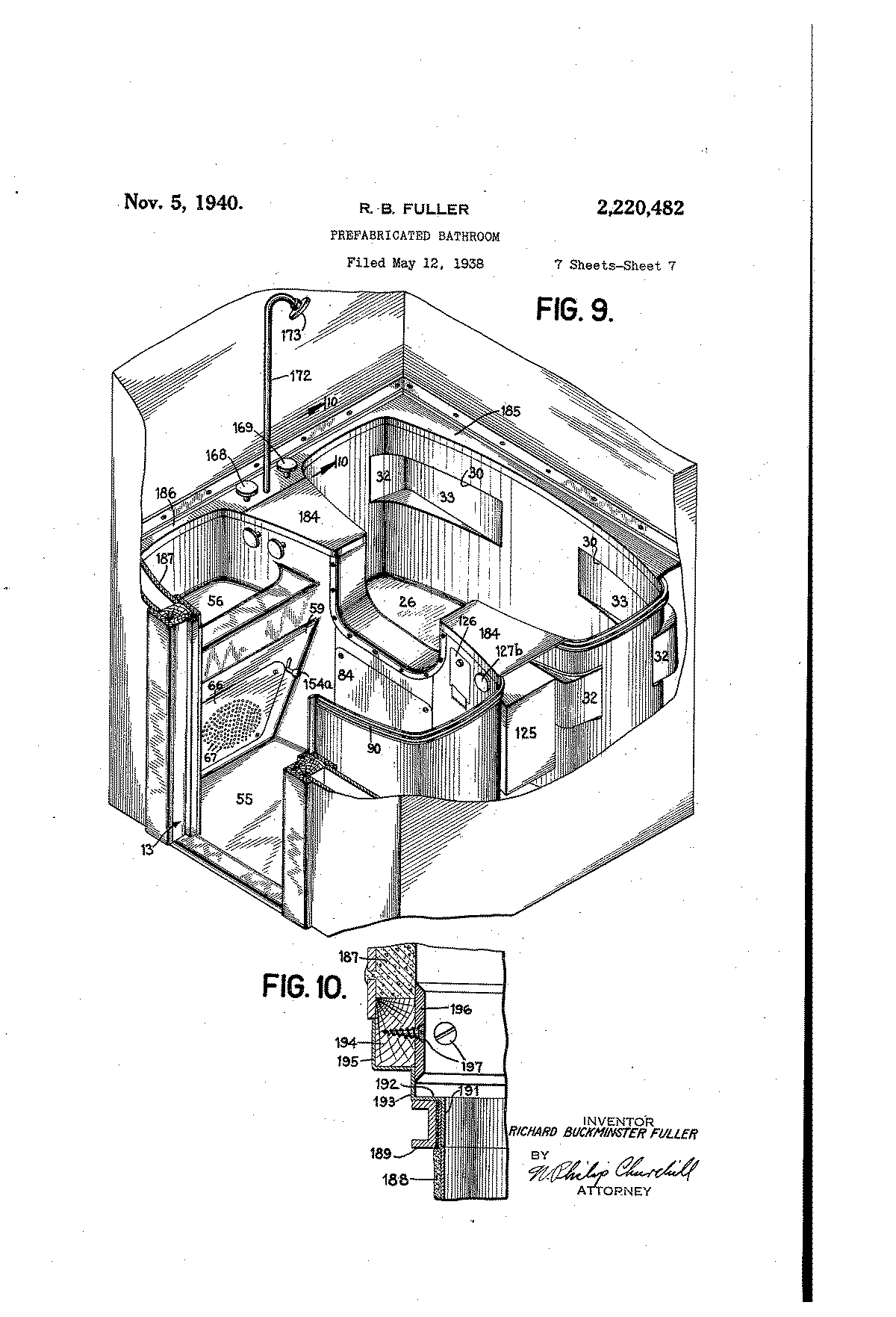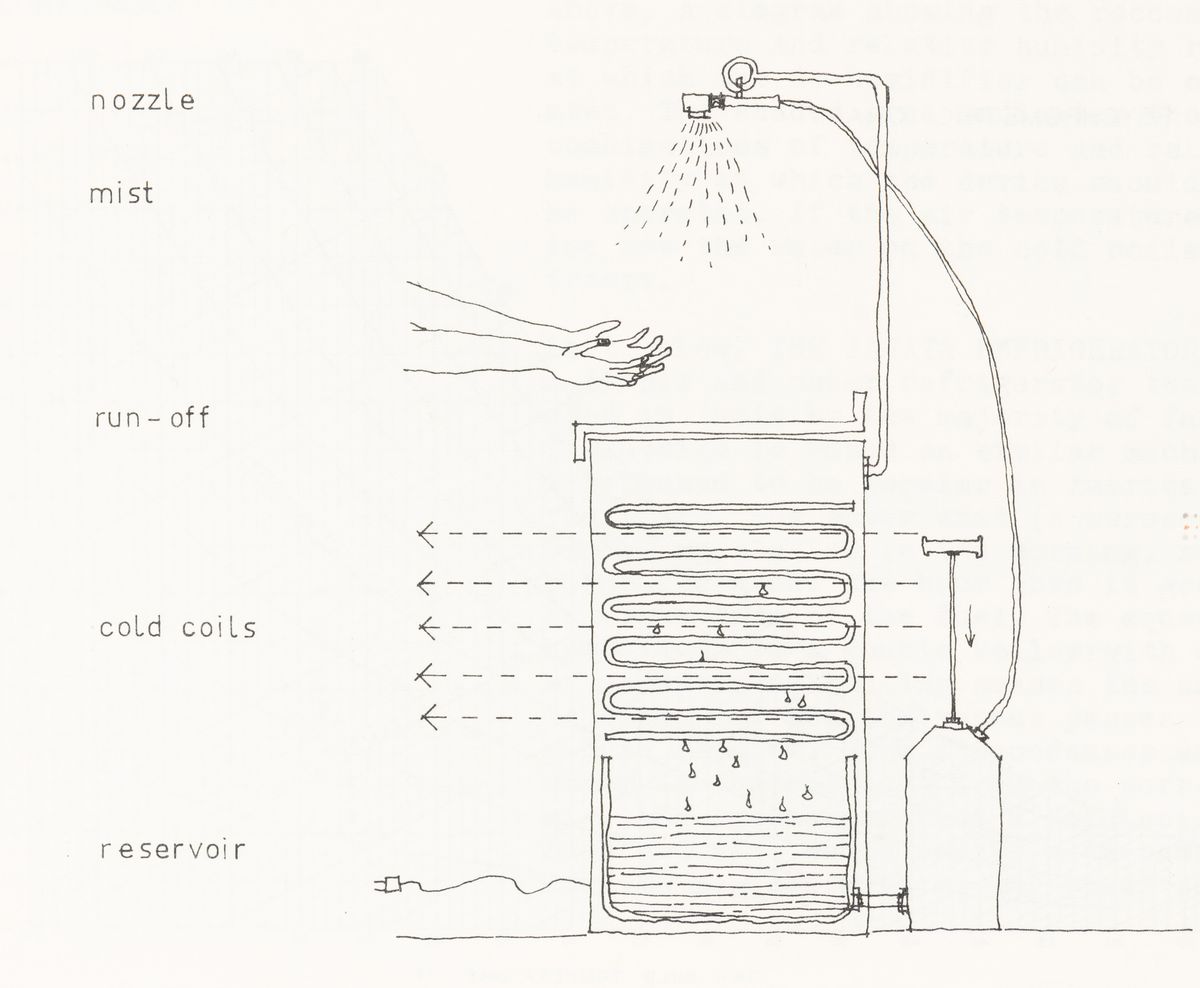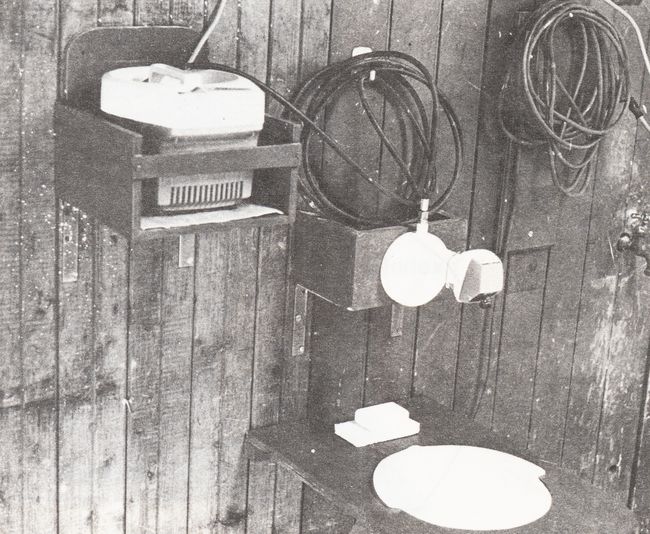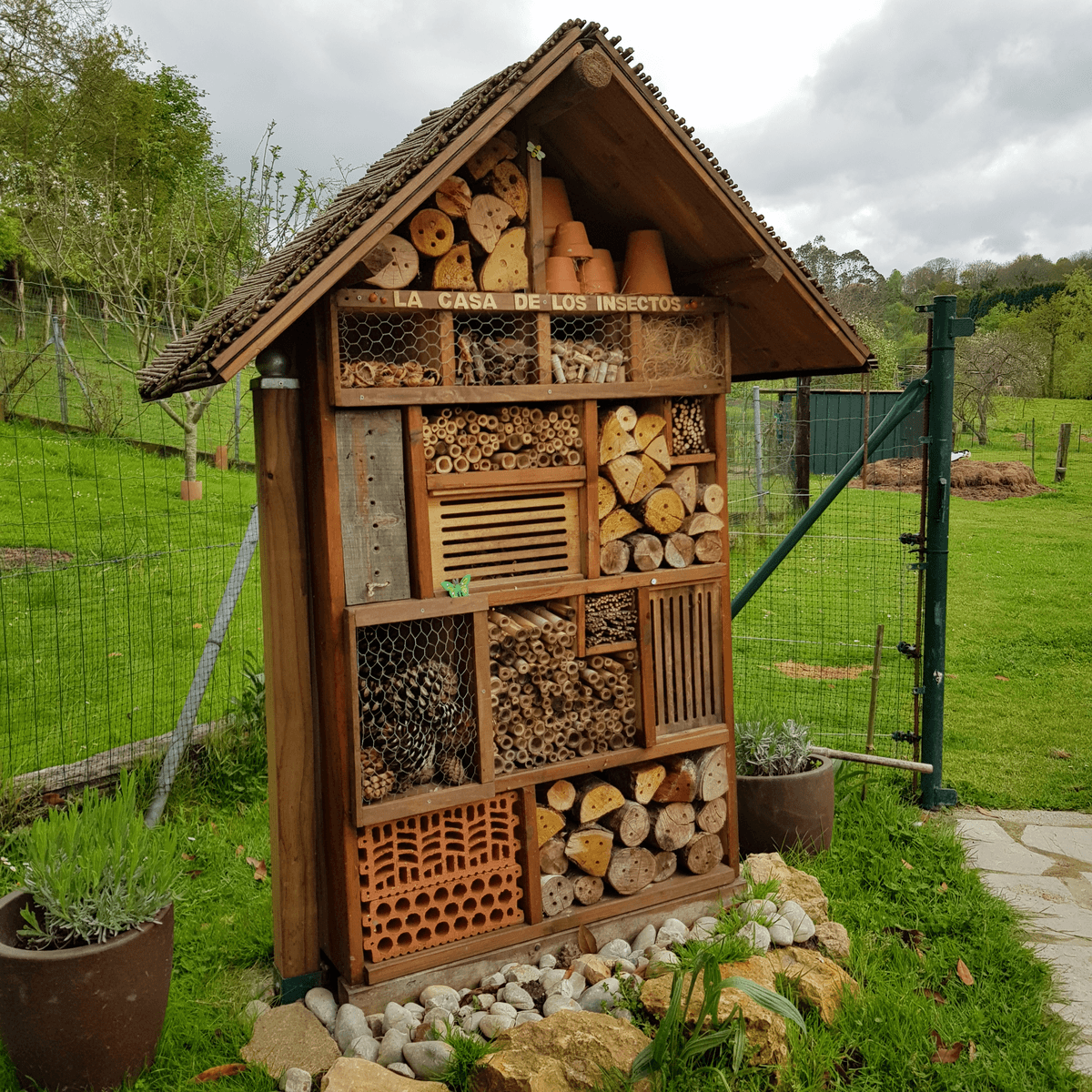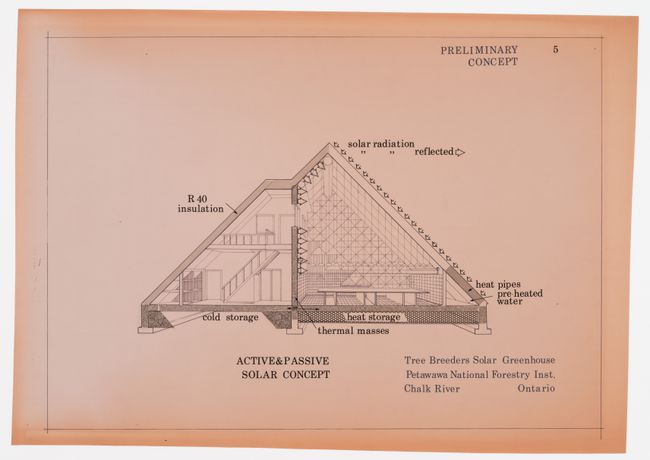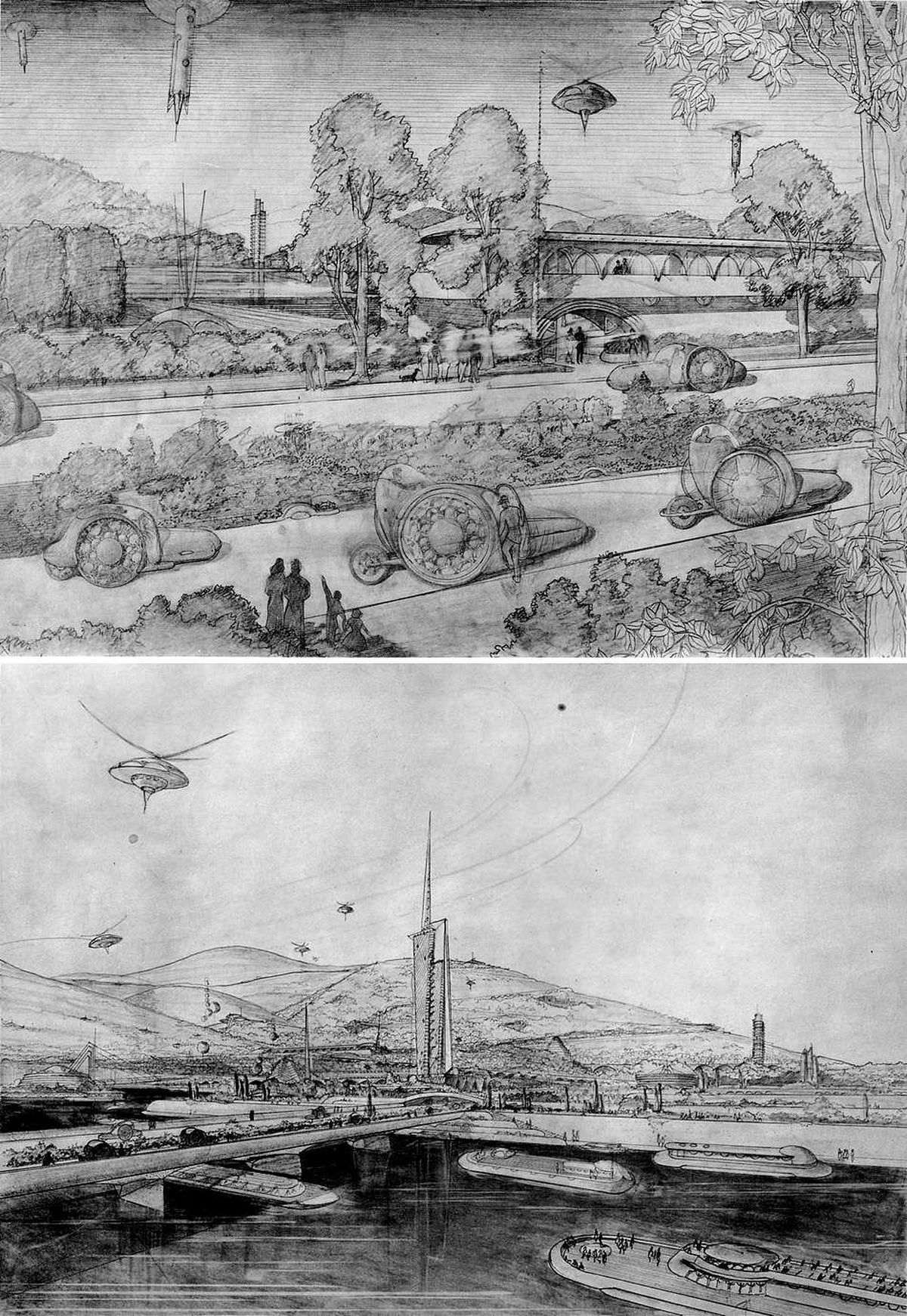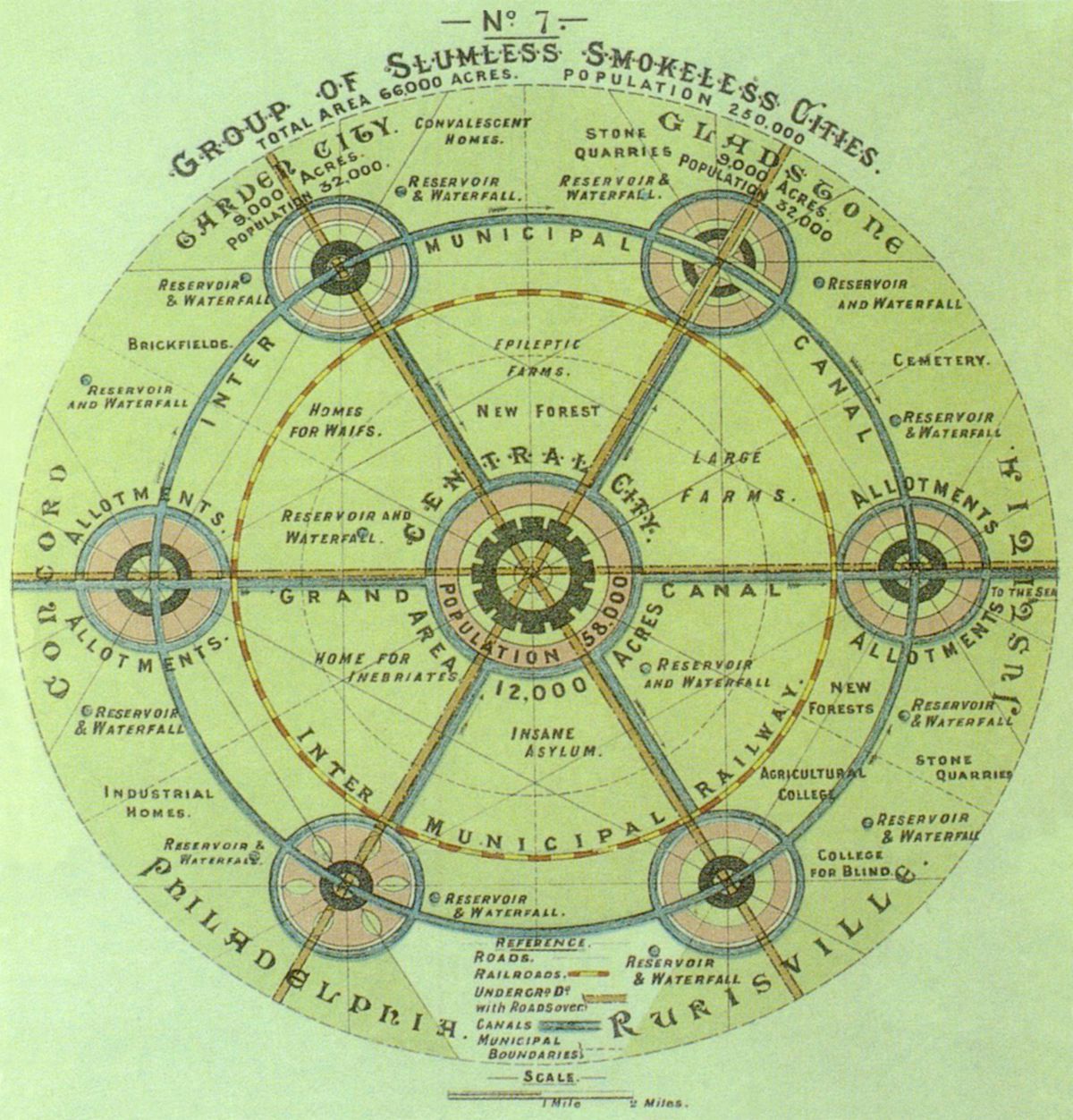In the Scale of… an Atom, a Water Droplet, a Human Being
Eliyahu Keller, Jessica Ngan, and Jonatan Palmblad
This is the fifth and final installment of “In the Scale of…” a series of counterproposals to conventional constructs of scale, authored by the participants of our 2020 Toolkit for Today and introduced by Émélie Desrochers-Turgeon and Eliyahu Keller in this article. In the following texts, Eliyahu Keller addresses architectural imagination in the nuclear age, Jessica Ngan examines research into the use of pressurized mist for agricultural or domestic work, and Jonatan Palmblad recalls Lewis Mumford’s observations on hostile environments and technological progress. Each author explores how things at a very small scale, relatively speaking, have consequences at a very large (and potentially unmanageable) one.
In the Scale of an Atom
Eliyahu Keller
Raymund J. Abraham (1933–2010), The House without Rooms Project, elevation and plan, 1974. Colour pencil, graphite, and cut-and-pasted printed paper on paper, 87.9 x 96.8 cm. Digital Image © The Museum of Modern Art, New York. Gift of The Howard Gilman Foundation. Licensed by SCALA/Art Resource, NY. © Estate of Raimund Abraham.
…the smallest parts of matter are found to be capable of exploding deeply entrenched ideas and large cities.1
What is the scale of an atom? Supposedly, the answer lies within the question. Etymologically denoting indivisibility, the atom derives its name from being the smallest of all things, producing a measure from which scaling down is no longer possible. Even though nuclear and quantum physics have demonstrated that further division is possible, language itself seems to have become entangled with the idea of indivisibility: everything smaller than an atom must be referenced against and scaled to the atom itself, from atomic to sub-atomic scales. And yet it is precisely this further division—beyond the supposedly smallest scale—that unleashed the “force from which the sun draws its power,” or “the basic power of universe.”2 As Karen Barad noted in their inquiry into implications of quantum physics on the construction of human knowledge, this power can irrevocably destroy both matter and meaning.
Following the unleashing of this threat of nuclear power to both ideas and cities, a slew of works attempted to scale the power of the atom into something that human minds can confront. Among those worth noting is Riddley Walker, Russell Hoban’s 1980 novel depicting a world some two-thousand years into the future after a nuclear apocalypse. In it, a small surviving civilization lives in a kind of iron-age condition, with little memory of the world that has been lost. Most significant, however, is Hoban’s use of the English language, which makes reading the novel a disorienting and even daunting task. As if contaminated by nuclear radiation, it is the words themselves, their spelling, grammar, and syntax, that have transformed. References explode, meanings change, and words mutate, becoming signs for things they were never intended to signify.3
Architecture, threatened most visibly by nuclear weapons, appeared in an array of fictional narratives as that thing that is destroyed. Yet architects were mostly absent from the conversation about the change of meaning brought about by the nuclear age, focusing instead on providing pragmatic solutions—such as fallout shelters or plans for urban dispersal—to a threat from which there is no hiding. Nonetheless, in several cases, architectural imagination was influenced by nuclear fictions, and transformed into something that instead of preventing, or at best surviving, the nuclear threat, could make that threat graspable; to scale it, so to speak, so that it can be confronted.
Take, for instance, the series of imaginary houses drawn by Raimund Abraham throughout the 1970s, all of which appear as if “suspended,” as Kenneth Frampton notes, “in the metaphysical landscape of a nuclear aftermath,” and “destined to be sites of new beginnings.”4 Simultaneously ruined and in the process of becoming, however, the houses should equally be considered as markers of the historical impossibility of representing an unimaginable end. With all referents of what a house might be obliterated, Abraham’s houses present an image of architecture that is not unlike the English language used in Riddley Walker: one that requires a recalibration of the very terms associated with that architecture—be those “domesticity,” “shelter,” or “survival”—in the face of an unprecedented world.
Absent in Abraham’s drawings is any sense of context, perhaps prompting Frampton’s description of the post-apocalyptic landscape as “metaphysical.” Yet what they do reveal is not the imagination of “new beginnings” noted by Frampton but rather the impossibility of confronting, imagining, and understanding a kind of devastation after which no beginning is possible. Examined from our contemporary vantage point—a time when nuclear threats have withdrawn unjustly into the shadows, only to be replaced with the equally unscalable threat of the climate crisis—these houses expose everything that architecture has failed to address, and that it is the environment, the soil, the landscape, indeed the planetary field, that can no longer be imagined as a clean, metaphysical, and blank slate.
-
Karen Barad, Meeting the Universe Halfway: Quantum Physics and the Entanglement of Matter and Meaning (Durham: Duke University Press Books, 2007), 3. ↩
-
“Truman Statement on Hiroshima,” Atomic Heritage Foundation, https://www.atomicheritage.org/key-documents/truman-statement-hiroshima. President Harry Truman made this statement on 6 August 1945, after the bombing of Hiroshima. ↩
-
Take for instance, the first line of the novel: “On my naming day when I come 12 I gone front spear and kilt a wyld boar he parbly ben the las wyld pig on the Bundel Downs any how there hadnt ben none for a long time befor him nor I aint looking to see none agen.” Russell Hoban, Riddley Walker (London: Bloomsbury Publishing, 2012), 1. ↩
-
Kenneth Frampton, “A Note on Raimund Abraham 1986.” AP197.S1.SS9.001, Kenneth Frampton fonds, CCA. Gift of Kenneth Frampton. Later published as Kenneth Frampton, “Fragmentary Notes,” in Raimund Abraham [UN]BUILT, ed. Brigitte Groihofer (Wien; New York: Springer, 2011), 216. ↩
In the Scale of a Water Droplet
Jessica Ngan
In the early 1970s, the Minimum Cost Housing Group at McGill University published a series of publications called The Problem Is…, which described its architecture research. Pervading these texts is a sense that the problems it explored were both far off and in the periphery yet encroaching closer and closer if not attended to.1 The fourth in the series, Water Conservation and the Mist Experience, proposed a new way of washing both objects and human bodies using a fine, pressurized water mist. Water misters, while themselves very small, were aimed at addressing planetary-scale problems of water scarcity and pollution.2
-
On the influence of Cold War securitization and ecological thinking in architecture, see Felicity Scott, Outlaw Territories: Environments of Insecurity/Architectures of Counterinsurgency (New York: Zone Books, 2016). ↩
-
The first year of the Minimum Cost Housing Group’s research was dedicated to investigating domestic water shortage issues. Other water-related research projects included a toilet design: Witold Rybczynski, Stop the Five Gallon Flush! A Survey of Alternative Waste Disposal (Minimum Cost Housing Group, 1973). Bound volume of electrophotographic print on paper, 28.2 × 22.3 × 0.4 cm. ARCH253665, Minimum Cost Housing Group fonds, CCA. Gift of Vikram Bhatt. © Minimum Cost Housing Group. Featured in Lee Stickells, “Flushing Out Some Sanitary Pamphlets,” CCA, October 2015, https://www.cca.qc.ca/en/articles/issues/19/the-planet-is-the-client/2260/flushing-out-some-sanitary-pamphlets. ↩
Samir Ayad and Witold Rybczynski, The Problem Is (Montreal: Minimum Cost Housing Studies, McGill University, 1971). Bound volume of electrostatic print on paper, 28.2 × 21.9 × 0.8 cm. ARCH253666, Minimum Cost Housing Group fonds, CCA. Gift of Vikram Bhatt.
The front cover of Minimum Cost Housing Group’s first publication with a negative image of an atomized spray mist.
The spray mister atomizes water by directing a fast stream of air over a vertical tube of water. The pressure difference between the water container and the stream of air forces water into the stream of air, which disperses the water into small droplets. The Minimum Cost Housing Group surveyed a range of mass-produced nozzles made for agricultural use and for home gardening, painting, and cleaning products. These products came onto the market in the wake of Buckminster Fuller’s design for a “fog gun,” patented in 1938, which was part of a prefabricated bathroom design commissioned by the copper mining company, Phelps Dodge.1 Fuller continued experiments in the late 1940s at the Illinois Institute of Technology Institute of Design and at Yale University on the therapeutic effects of hour-long massaging baths using pressurized water and heat lamps. Before Alvaro Ortega cofounded the Minimum Cost Housing Group in the early 1970s, he had seen the use of pesticide sprayers for mist washing in the Proyecto Experimental de Vivienda (PREVI), a social housing project in Lima, Peru.2
-
Fuller visited Montreal in 1971 and tried the Minimum Cost Housing Group’s hand washer. ↩
-
Samir Ayad and Witold Rybczynski, The Problem Is (Montreal: Minimum Cost Housing Studies, McGill University, 1971), 234. Ortega was a consultant to the United Nations during the period of a 1968 pilot project in Lima, in which the UN gave water misters to five families for two years. ↩
By the early 1970s, small objects with large-scale impacts proliferated in ecological discourse—both in popular literature and the architecture discourse generated by it. For example, in his 1973 book Small is Beautiful: A Study of Economics as if People Mattered, statistician and economist Ernst. F. Schumacher posits the idea of smallness as a solution to a wide array of problems related to modernization and development. Environmental activism in the 1960s drew attention to water and air pollution, rendering landscapes that appeared outwardly healthy as ones in fact contaminated by industrial pollutants that were only visible in the laboratory through chemical testing. The Minimum Cost Housing Group’s design project for new ways of washing was carried out at the scale of the water droplet. With extensive testing, it compared the patterns, densities, and sizes of water droplets produced by a variety of commercially available spray nozzles. A well-designed spray mist would remove dirt and soap while drastically reducing water usage. It was the value-added engineering of a stream of water. What was the mist experience? According to its testers, the mist, compared to the driving rain of conventional washing, was a gentle rain. This nuanced difference encapsulates how planetary problems of water scarcity and pollution are experienced, not only as catastrophic weather events but as small yet fundamental differences in daily life.
Alexander B. Morse and Witold Rybczynski, Water Conservation and the Mist Experience (Montreal: Minimum Cost Housing Group, McGill University, 1978), 17. Bound volume of electrophotographic print on paper, 21.4 × 17.4 × 0.4 cm. ARCH273145, Minimum Cost Housing Group fonds, CCA. Gift of Vikram Bhatt.
A spray mister used for hand washing at the Minimum Cost Housing Group’s workshop. A Black and Decker air compressor for spray painting is repurposed to provide air pressure for the spray mister.
In the Scale of the Human Being
Jonatan Palmblad
We are, according to some, said to live in the Anthropocene—“the human epoch.”1 Yet the processes that now undermine the ecology and climate we rely on for long-term survival and prosperity are, in a peculiar way, disproportionate when compared to actual individual human lives. No single human being can impede these processes and no individual is solely accountable for them, but we are subject to their effects en masse. One could say, then, that the human epoch is beyond the human scale.
In the 1920s, long before the notion of the Anthropocene was coined, Lewis Mumford (1895–1990) began pondering why collective human ventures so often result in environments hostile to our own wellbeing despite being realized with increasingly efficient technology. One of his early and repeated targets of critique was the skyscraper, since, when built close together with other towers in the gridiron urban plan, it served to maximize profit rather than to increase human wellbeing. Following Aristotle, Mumford argued that the good life must be the overarching goal of architecture and civilization, and to achieve this, questions of scale and proportion were of utmost importance.2 Humans may not be the measure of all things, but Mumford believed that we ought to at least be the measure for the built environments we inhabit.
-
Paul Crutzen, “The Geology of Mankind,” Nature 415, no. 6867 (January 2002): 23. Since being coined in 2000, the term has gone on to live its own life both within and beyond the scientific discourse. ↩
-
Lewis Mumford, Sticks and Stones: A Study of American Architecture and Civilization (New York: Boni and Liveright, 1924), 172–177. In the first book of the Nicomachean Ethics, Aristotle argues that the chief end of all “arts” is eudaimonia, or the good life. ↩
Biocentrism and ecocentrism may seem like remedies to the Anthropocene, but Mumford would likely have said that we are not anthropocentric enough. His “human” was a living, ecologically enmeshed being, not an abstraction disconnected from the environment. Understanding humans in this way, anthropocentrism makes for a human ecology. Mumford therefore embraced Frank Lloyd Wright’s organic architecture, in which human dwellings were conceived of in relation to their surroundings. Moreover, he saw in Wright’s work an effort to mend the growing gap between art and technology, which he believed was necessary in order for architects to not become servants of the means we create.1 In the end, however, Mumford believed that we had to go beyond individual buildings and cities, for a regional planning in which the ecology was more explicitly accounted for was needed. For humans to prosper, so must the entire web of life.2
-
Lewis Mumford, “The Social Background of Frank Lloyd Wright,” in Frank Lloyd Wright: The Complete 1925 “Wendingen” Series, Frank Lloyd Wright et al. (New York: Dover Publications, Inc., 1992), 65–79. ↩
-
See the exposition of regional planning in Lewis Mumford, The Culture of Cities (New York: Harcourt, Brace and Company, 1938): 300–392. Mumford argues that “every living creature is part of the general web of life: only as life exists in all its processes and realities . . . can any particular unit of it continue to exist.” Mumford, 302. ↩
De Paoli & Pellissier, Tree Breeders Solar Greenhouse, Petawawa National Forestry Institute, Chalk River, Ontario, 1977. Black ink and adhesive film on translucent paper, 47 x 66 cm. ARCH279071, Giovanni de Paoli and Pierlucio Pellissier fonds. Gift of Pierlucio Pellissier © CCA.
The passive use of energy in architecture builds upon principles in nature that Mumford already championed in 1924 in Sticks and Stones. While we can “design with nature,” as landscape architect Ian McHarg put it, Mumford pointed out that we tend to use technological solutions, such as artificial lighting and air conditioning, to detach the building from its environment—at the cost of a higher energy use.
In his last books, Mumford argued that humans had created a “Megamachine”—a system so vast that we cannot see that we are ourselves parts of its mechanism.1 We create urban environments through which humans can function in a global economy but in which they cannot flourish locally. As pollution, species extinction, and climate change pervade all scales at increasing rates, and as we ourselves shrink in the shadow of the technological sublime, Mumford’s predictions are unfortunately gaining relevance. Perhaps, then, the answer to the human predicament lies in architecture. This holds true at least to some extent: we are literally building our future, and it matters whether we construct more Burj Khalifas or more ecologically adapted settlements for the good of actual human beings. At any rate, it is hard to deny that, as our problems reach planetary dimensions, the supposedly human epoch is neither human nor humane in its scale.
-
Lewis Mumford, The Myth of the Machine, vol. 1, Technics and Human Development (New York: Harcourt, Brace, Jovanovich, 1967); Lewis Mumford, The Myth of the Machine, vol. 2, The Pentagon of Power (New York: Harcourt, Brace, Jovanovich, 1970). ↩
